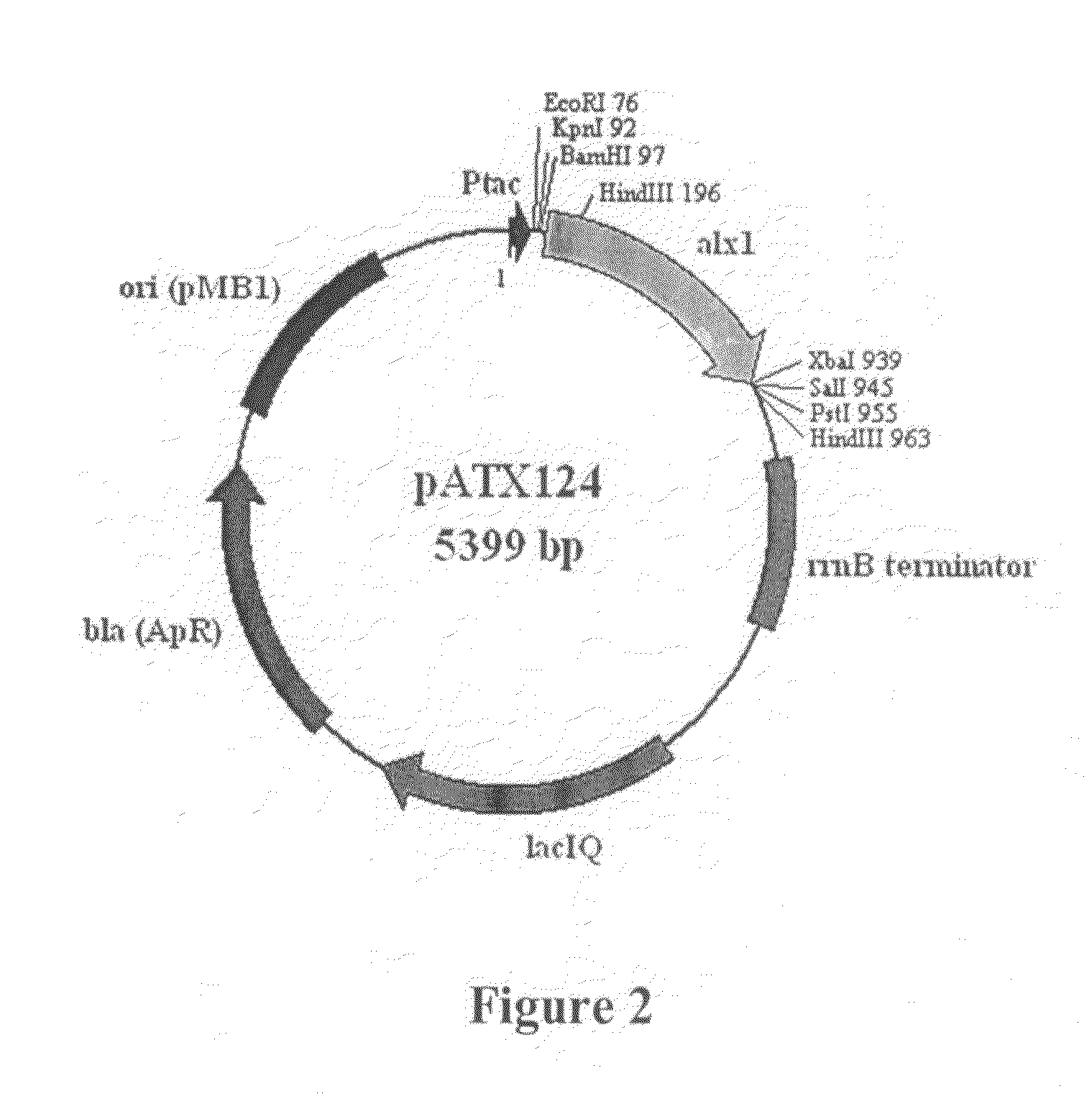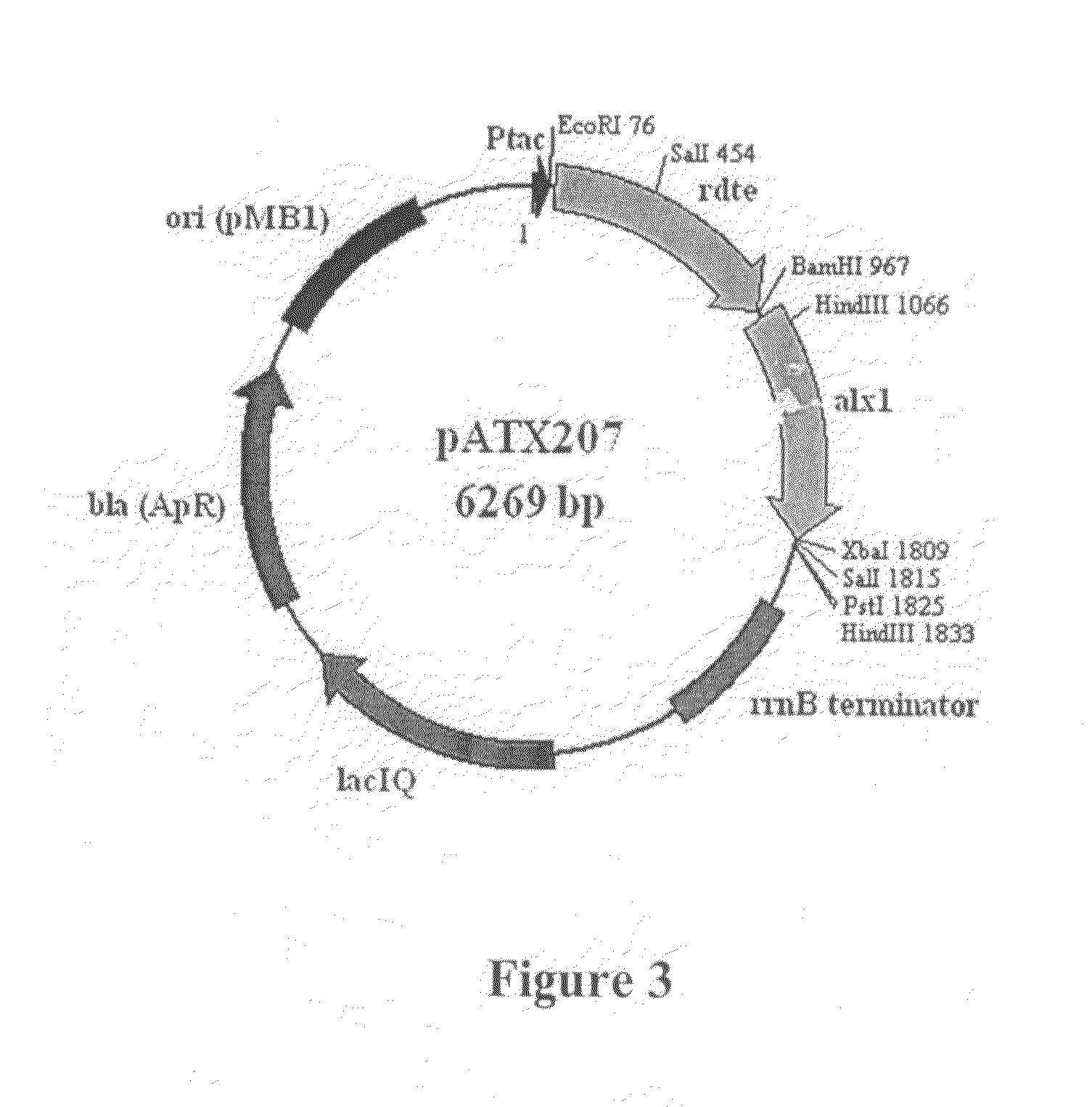Method for microbial production of xylitol from arabinose
a technology of xylitol and arabinose, which is applied in the field of recombinant microorganisms effective can solve the problems of difficult separation and no bacteria have been reported for producing xylitol from arabinos
- Summary
- Abstract
- Description
- Claims
- Application Information
AI Technical Summary
Benefits of technology
Problems solved by technology
Method used
Image
Examples
example 1
[0069]Cloning of the Ambrosiozyma monospora L-Xylulose Reductase Gene (alx1), the Rhizobium radiobacter D-Tagatose 3-Epimerase Gene (rdte) and Escherichia coli L-Arabinose Isomerase Gene (araA) and Construction of an L-Arabinose Isomerase / D-Tagatose 3-Epimerase / L-Xylulose Reductase Operon (araA / rdte / alx1)
[0070]The A. monospora L-xylulose reductase gene (alx1) was cloned by RT-PCR using primers designed from the published sequence (GenBank Acc. No. AJ583159, SEQ ID No. 17) (Verho, 2004, ibid). A. monospora NRRL Y-1484 was grown overnight on YM medium containing 2% (w / v) L-arabinose. Total RNA was isolated using the RNeasy kit (Qiagen, Valencia, Calif., USA). The gene was amplified using the specific primers (Table 1, SEQ ID Nos. 1 and 2) and the One-Step RT-PCR Kit (Qiagen, Valencia, Calif., USA) with a DNA Engine Peltier Thermal Cycler PCR machine (BioRad, Hercules, Calif., USA), using standard amplification parameters. The RT-PCR reaction yielded a single band by gel electrophoresi...
example 2
[0074]Xylitol Synthesis from L-Arabinose Using the araA / rdte / alx1 Operon
[0075]To test the activity of the araA / rdte / alx1 operon, plasmid pATX208 was transformed into E. coli strain BW25113′ (Datsenko, 2000) by electroporation (BW25113 / pATX208). The strain was inoculated from a single colony into 3 ml LB medium supplemented with 200 mg 1−1 ampicillin and incubated overnight at 30° C. with shaking (250 rpm). An aliquot of the overnight culture was diluted 100-fold into 20 ml of fresh LB medium containing 1% (w / v) L-arabinose and 200 mg 1−1 ampicillin and incubated (30′C, 250 rpm) for 2 hours. To induce transcription of the operon under control of the tac promoter, isopropyl-β-D-thiogalactopyranoside (IPTG, 1 mM) was added to the cultures. The cultures were further incubated at 30° C. with shaking (250 rpm) and aliquots were removed at various time points after the IPTG induction. The strain carrying pTTQ18 (vector only) was used as a negative control. The samples were monitored for xy...
example 3
[0076]Construction of the L-Arabinose Isomerase / D-Tagaotose 3-Epimerase / L-Xylulose Reductase (araA / rdte / alx1) Operon Driven by the araBAD Promoter (PBAD) and Xylitol Synthesis from L-Arabinose Using the PBAD-araA / rdte / alx1 Operon
[0077]Plasmid pATX208 was digested with restriction enzymes EcoRI and SphI using standard conditions. The digested plasmid DNA was loaded onto an agarose gel and then a 3.3-kb DNA fragment containing the araA / rdte / alx1 operon was extracted and purified from the gel using the QIAquick Gel Extraction Kit (Qiagen, Valencia, Calif., USA). The extracted DNA fragment was ligated using the Quick Ligation Kit into an expression plasmid, pBAD18-Kan (Guzman et al., 1995, J. Bacteriol. 177: 4121-4130), restricted with the same enzymes to yield pATX210 (FIG. 5).
[0078]To test the expression and activity of the araA / rdte / alx1 operon under control of the araBAD promoter (PBAD) plasmid pATX210 was transformed into strain BW25113 by electroporation (BW25113 / pATX210). The str...
PUM
| Property | Measurement | Unit |
|---|---|---|
| Fraction | aaaaa | aaaaa |
| Fraction | aaaaa | aaaaa |
| Fraction | aaaaa | aaaaa |
Abstract
Description
Claims
Application Information
 Login to View More
Login to View More - R&D
- Intellectual Property
- Life Sciences
- Materials
- Tech Scout
- Unparalleled Data Quality
- Higher Quality Content
- 60% Fewer Hallucinations
Browse by: Latest US Patents, China's latest patents, Technical Efficacy Thesaurus, Application Domain, Technology Topic, Popular Technical Reports.
© 2025 PatSnap. All rights reserved.Legal|Privacy policy|Modern Slavery Act Transparency Statement|Sitemap|About US| Contact US: help@patsnap.com



